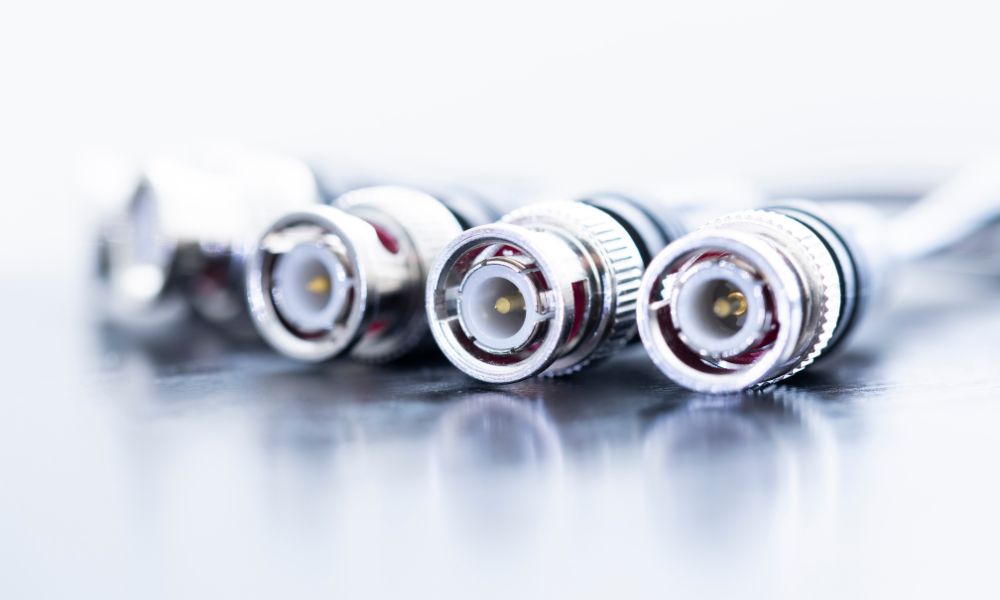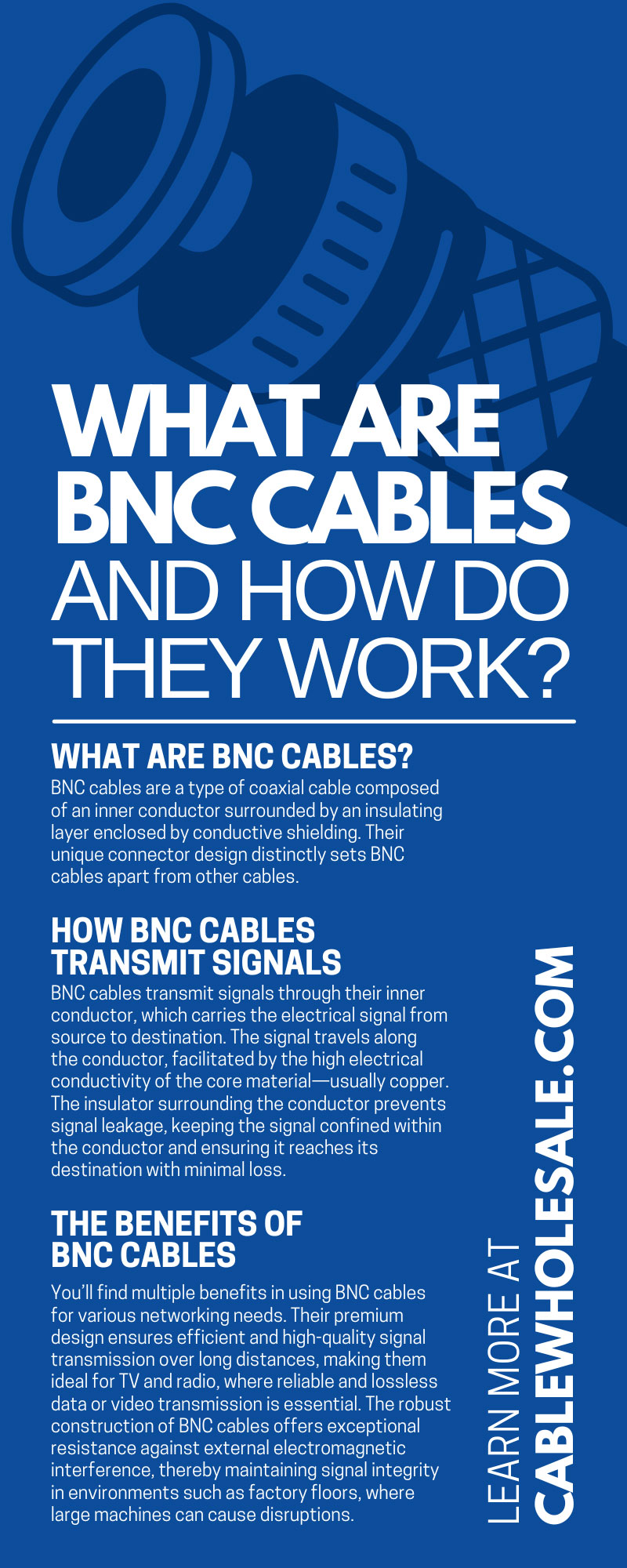
BNC cables, or Bayonet Neill-Concelman cables, are pivotal components in a broad spectrum of technology sectors. They are integral to various applications, but not many people know of them. Discover what BNC cables are and their uses as we underscore their pivotal role in contemporary technology.
What Are BNC Cables?
BNC cables are a type of coaxial cable composed of an inner conductor surrounded by an insulating layer enclosed by conductive shielding. Their unique connector design distinctly sets BNC cables apart from other cables.
The BNC connector comprises a bayonet coupling mechanism, ensuring secure and reliable connections. This feature, coupled with their ability to efficiently transmit high-frequency electrical signals with minimal loss, makes BNC cables a preferred choice for critical applications, such as video and data transfers.
The History of BNC Cables
Over the years, numerous technological advancements have created a need for cables with different functions, and the BNC cable has remained a reliable option. Initially, military and aerospace industries used these cables due to their high reliability and efficiency in transmitting radio frequency signals for clear communications. Today, the capabilities of BNC cables extend to even more sophisticated applications, such as 4K video transmission and high-speed networking, marking a significant milestone in their evolutionary journey.
The Design and Construction of BNC Cables
The design and construction of BNC cables involve meticulous attention to materials and design requirements. Manufacturers typically create the inner conductor, the backbone of the cable, with a high-conductivity material such as copper, known for its excellent electrical transmission properties. An insulating layer encases the conductor, commonly made of polyethylene or a comparable material, to prevent signal leakage and enhance transmission accuracy.
A second layer of conductive material, often a copper braid, envelops the insulator as a barrier to external electromagnetic interference. The outermost layer or jacket, usually constructed from PVC or a similar durable material, provides mechanical protection and ensures the cable’s longevity.
The distinctive BNC connector, made from a rigid and corrosion-resistant material such as nickel or brass, facilitates secure and efficient signal transmission. Its bayonet coupling design, marked by a pin and collar system, guarantees a reliable and stable connection, even in environments with vibration or movement.
Types of BNC Cables
Various types of BNC cables suit specific applications, each featuring unique characteristics. Learn about the uses of certain types of BNC cables.
- Standard BNC cables are typical in applications such as video and radio frequency signal transmission due to their robust performance in these areas.
- High-resolution BNC cable, specifically engineered for high-definition video applications such as HDTV, has superior signal fidelity.
- Thinnet BNC cables are a lightweight, flexible variant, often used in temporary setups or installations where cable weight and maneuverability are critical.
- Thicknet BNC cables have more permanent installations where durability and signal quality are paramount. These cables boast a heavy-duty design and enhanced shielding for superior interference resistance.
- Triaxial BNC cables are common in highly demanding environments, including broadcast studios, offering the highest level of signal isolation among all BNC cables.
How BNC Cables Transmit Signals
BNC cables transmit signals through their inner conductor, which carries the electrical signal from source to destination. The signal travels along the conductor, facilitated by the high electrical conductivity of the core material—usually copper. The insulator surrounding the conductor prevents signal leakage, keeping the signal confined within the conductor and ensuring it reaches its destination with minimal loss.
The outer conductive shielding serves as a protective barrier against potential electromagnetic interference from external sources, preserving the integrity and quality of the signal during transmission. With its bayonet coupling system, the unique BNC connector provides a secure and stable connection at the source and destination points, ensuring an uninterrupted and efficient signal flow.
BNC Cables Across Industries
BNC cables established their presence across multiple industries as a reliable network cable. In the telecommunications industry, they are popular for facilitating high-speed data networks and ensuring fast and disturbance-free data transmission. Broadcasting and media production industries value BNC cables for their exceptional performance in transmitting high-definition video signals, making them an integral part of modern television studios.
Security organizations use these cables in CCTV systems for real-time and high-resolution video feeds. The aerospace and defense sectors, where BNC cables started, depend heavily on BNC cables for reliable and precise signal transmission.
The Benefits of BNC Cables
You’ll find multiple benefits in using BNC cables for various networking needs. Their premium design ensures efficient and high-quality signal transmission over long distances, making them ideal for TV and radio, where reliable and lossless data or video transmission is essential. The robust construction of BNC cables offers exceptional resistance against external electromagnetic interference, thereby maintaining signal integrity in environments such as factory floors, where large machines can cause disruptions.
BNC connectors’ unique bayonet coupling system guarantees secure and stable connections, fostering enhanced reliability in dynamic settings. Similarly to factories, many construction sites use these cables to avoid the disconnection of signals for communication since many large machines create rumbles that could cause cables to unplug. Additionally, the availability of multiple types of BNC cables allows for customization and optimization according to unique industry requirements.
The Drawbacks of BNC Cables
Despite their myriad benefits, BNC cables have certain drawbacks worth considering. Due to their specific connector design, BNC cables require compatible devices, limiting their versatility. Installing BNC cables may require more space during installation in tight spaces, given their bulkier design than other coaxial connectors. Additionally, while BNC cables have excellent high-frequency performance, their efficiency may decrease over vast distances. It’s essential to weigh these potential drawbacks against the numerous advantages BNC cables offer when considering them for your specific needs.
BNC Cables vs. Other Coaxial Cables
When comparing BNC cables with other coaxial cables, it’s crucial to consider their unique attributes and advantages. With their robust construction, excellent signal quality, and reliable connectors, BNC cables stand out as a superior choice for many applications. For instance, while RCA cables may have more use in consumer electronics, their connectors are less secure and may come loose. BNC connectors are a more reliable choice for professional settings thanks to their bayonet design.
Similarly, television and satellite connections use F-type cables due to their low cost. They lack the secure and quick-release coupling mechanism of BNC connectors, making them less suitable for applications where signal integrity and connection stability are paramount. So, the next time you consider buying bulk coaxial cables, consider purchasing BNC cables for an improved connection.
Best Practices for BNC Cable Maintenance
Regular maintenance for BNC cables is paramount to ensure their durability and optimal performance. Check for any signs of corrosion or loose fittings around the connector and any kinks or tearing on the jacket.
Wherever possible, disconnect and store cables in a clean, dry environment when not in use to protect them from dust and moisture. Always use compatible devices and follow the manufacturer’s instructions during installation and removal to uphold the longevity of your BNC cables.




